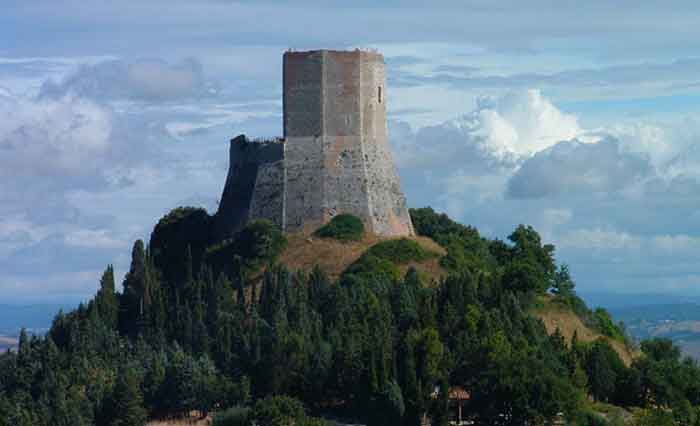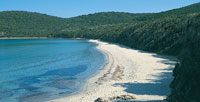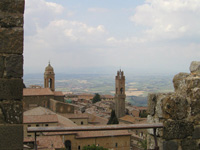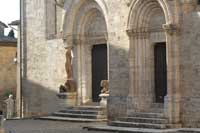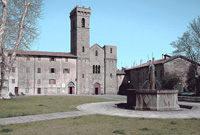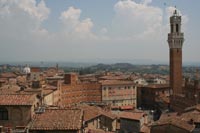|
Rocca d'Orcia is a frazione of Castiglione d'Orcia and is located one kilometer north of Castiglione. The village has an imposing octagonal fortress, the Rocca a Tentennano. Follow the signposts Rocca a Tentennono and park in the parking lot at the bottom of the fort. Just for the magnificent views of the Orcia valley and Monte Amiata, a visit to Rocca d'Orcia is worthwhile. |
||
| Vivo d'Orcia is a small village, just a few kilometres north of Abbadia San Salvatore. Particularly interesting here is a visit to the former hermitage or settlement that lies just below the village in a romantic setting on the bank of the river Vivo. One can only reach the settlement on foot which is signposted from the village ("Eremo - Via IV Novembre). The path leads across a stone bridge, past the ruin of a former mill and a castle, which is now privately owned, and finally through an archway to the Borgo Principale. Surrounded by vegetation, Eremo del Vivo also known as the Contea, is characterized by the presence of the imposing Palazzo Cervini, a fortified building on a plan by Antonio da Sangallo. The construction of Palazzo Cervini was commissioned in 1538 by Cardinal Marcello Cervini from Montepulciano. An old stone bridge covered in moss with the name Ponte degli Innamorati (lovers' bridge) marks the entrance to this romantic property. To the right is the castle, which is still lived in by the by members of the family. To the left is an arched stone doorway leading down to the hamlet which in the past housed the peasants and their families. Not far away from here, in the vicinity of the historic springs of Vivo is the church of the Ermicciolo, a wonderful example of the Amiata Romanesque architectural style. |
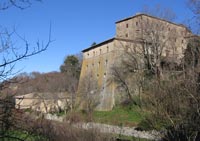 Palazzo Cervini near Vivo d'Orcia Palazzo Cervini near Vivo d'Orcia |
|
Walking in Tuscany | San Quirico d'Orcia, Bagni Vignoni, Castiglione d'Orcia, Rocca d'Orcia, Montalcino, La Foce
|
||
Radicofani (783m) is situated to the east of Monte Amiata strikingly placed on a basaltic hill overlooking the river valley Paglia. It preserves some remains of a castle built by the English pope Hadrian IV, in which Ghino di Tacco imprisoned the Abbot of Cluny, as related in the 'Decameron'. From the castle's tower, approx. Monticchiello is a pretty medieval walled town in the heart of the Val d'Orcia. The town walls, a great part preserved, are reinforced by towers of various dimensions and shapes. The village inside the fortifications has maintained its medieval characteristics and walking through its streets and alleyways is like 'breathing' Tuscan medieval life. The 13th century church, Chiesa dei Santi Leonardo e Cristoforo, was restored in 1933 revealing remarkable frescoes and a 5 metre high Christophorus depiction, "Grande Arcosolio" from the 15th century, which illustrates the life and times of the Holy Nicholas. From the square at the main gate is a wonderful view of the surrounding landscape of rolling hills and beautiful countryside scenery. The village is renowned not only for its beauty but also for the "teatro povero" di Monticchiello (poor theatre). Performances are conceived and interpreted by local people staging plays during the last week of July and the first two weeks of August and spotlighting the area's peasant, sharecropping history; inhabitants also compose the music and construct the scenery. From a "popular experiment" the theatrical experience of Monticchiello has become a significant example of Italian theatre. |
||
Comune di Castiglione d'Orcia | www.comune.castiglionedorcia.siena.it Tuscan treasures | Castiglione d'Orcia | Rocca d'Orcia |
||
Castiglione d'Orcia and the Val d'Orcia
|
||
| Enlarge map Val d'Orcia | ||
|
||
|
||||||||||||||||||||||||||||||||||||||||||||||||||
|
||||||||||||||||||||||||||||||||||||||||||||||||||
